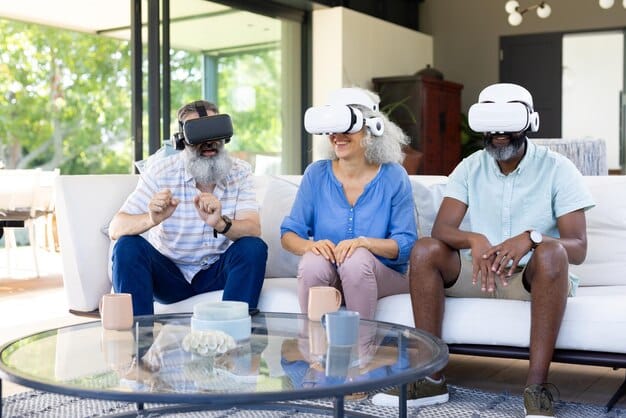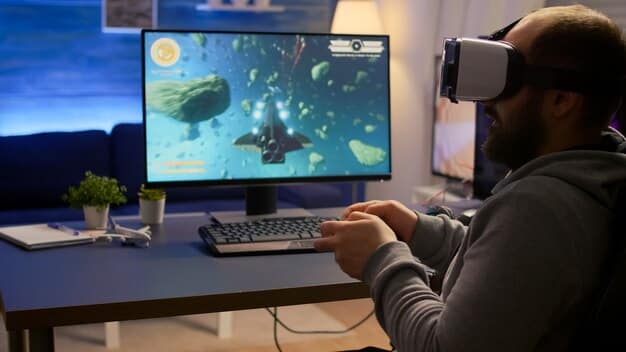VR ROI: Quantifying the Value of VR in Your US Business

VR ROI (Return on Investment) measures the financial benefits of implementing virtual reality (VR) solutions in your US company, encompassing increased efficiency, enhanced training, and improved customer engagement to justify VR investments.
Are you a US-based company considering investing in virtual reality (VR) technology? Understanding and measuring the VR ROI: Measuring the Return on Investment of VR Initiatives in Your US Company is crucial to making informed decisions and justifying your investment. Let’s delve into the strategies and metrics to effectively evaluate the financial impact of your VR initiatives.
Understanding the Fundamentals of VR ROI
Before diving into the specifics, it’s essential to grasp the basic concepts of VR ROI. This involves identifying the costs associated with your VR project and comparing them to the expected or achieved benefits.
This section will provide a roadmap to navigating the complexities of calculating VR ROI, tailored specifically for businesses operating within the United States.
Defining VR ROI
VR ROI is a performance measure used to evaluate the efficiency of an investment or compare the efficiency of a number of different investments. To calculate VR ROI, the benefit (or return) of an investment is divided by the cost of the investment; the result is expressed as a percentage or a ratio.
Why VR ROI Matters for US Companies
For US companies, demonstrating a positive VR ROI is essential for several reasons. Not only does it justify the initial investment, but it also helps secure further funding and support for future VR initiatives. VR can significantly enhance training programs by providing immersive, hands-on experiences, leading to better knowledge retention and skills development among employees. By creating realistic and engaging simulations, VR allows trainees to practice complex tasks and scenarios in a safe and controlled environment, reducing the risk of errors and improving overall performance.

- Cost Justification: Helps justify the initial investment in VR technology.
- Budget Allocation: Influences future budget allocations and resource planning.
- Competitive Advantage: Showcases innovation and a forward-thinking approach.
In conclusion, a clear understanding of VR ROI is paramount for US companies to make informed investment decisions and realize the full potential of this transformative technology.
Identifying VR Investment Costs
Calculating VR ROI accurately starts with a comprehensive understanding of all associated costs. This includes both direct and indirect expenses.
Let’s break down the various cost components that US companies should consider when evaluating the financial implications of their VR investments.
Hardware and Software Costs
The initial investment in VR hardware and software can be substantial. This includes the cost of VR headsets, controllers, and any specialized equipment needed to create a fully immersive environment.
Additionally, factor in the cost of software licenses and development tools required to create and deploy VR applications.
Development and Content Creation Costs
Creating high-quality VR content often requires specialized skills and resources. This can include hiring VR developers, designers, and content creators, or outsourcing these tasks to external agencies.
Consider the expenses associated with scripting, 3D modeling, and user interface design, as well as ongoing content updates and maintenance.
- Personnel: Salaries for VR developers, designers, and project managers.
- Training: Costs associated with training employees on VR technologies.
- Maintenance: Ongoing expenses for maintaining and updating VR hardware and software.
In summary, accurately identifying VR investment costs is critical for understanding the financial realities and potential returns of VR initiatives.
Quantifying the Benefits of VR Initiatives
Identifying and quantifying the benefits of VR initiatives is just as crucial as understanding the costs. This helps demonstrate the tangible value that VR brings to your organization.
This section explores the various ways VR can generate returns for US companies, focusing on key metrics that can be quantified.
Increased Efficiency and Productivity
VR can significantly improve efficiency and productivity by streamlining processes and reducing errors. For example, using VR for training can accelerate the learning curve and improve employee performance.
VR can revolutionize the way products are designed and developed by allowing engineers and designers to create, test, and iterate on virtual prototypes in a highly realistic and immersive environment. This approach offers numerous advantages over traditional methods, including reduced development costs, shorter time-to-market, and improved overall product quality.
Enhanced Training and Development
VR provides immersive, hands-on training experiences that lead to better knowledge retention and skills development. This can result in reduced training costs and improved employee performance.
By creating realistic and engaging simulations, VR allows trainees to practice complex tasks and scenarios in a safe and controlled environment, reducing the risk of errors and improving overall performance.

- Time Savings: Reduction in time spent on training and tasks.
- Error Reduction: Decrease in errors and mistakes in critical processes.
- Cost Savings: Lower costs associated with training materials and resources.
In conclusion, quantifying the benefits of VR initiatives is essential for understanding the true value of your VR investments and achieving optimal ROI.
Calculating VR ROI: The Formula and Metrics
With a clear understanding of both costs and benefits, you can begin calculating your VR ROI. This involves applying a standard ROI formula and tracking relevant metrics.
This section will guide you through the process of calculating VR ROI, providing practical examples and insights for US companies.
The Basic ROI Formula
The basic ROI formula is: ROI = (Net Profit / Cost of Investment) x 100. To apply this to VR, you need to define what constitutes “net profit” and “cost of investment” in your specific context.
Calculating VR ROI involves a straightforward formula applied to the specific context of VR initiatives. For instance, in retail, VR-enhanced shopping experiences that lead to increased sales can be directly translated into revenue gains, providing a clear and quantifiable return.
Key Metrics to Track
Several metrics can help you track the success of your VR initiatives and refine your ROI calculations. These metrics may include:
Employee engagement metrics quantify the level of involvement and enthusiasm employees exhibit when using VR tools or participating in VR training programs. Monitoring attendance rates, participation levels, and completion rates in VR training sessions provides valuable insights into the effectiveness and appeal of VR-based learning methods
- Training Completion Rates: Percentage of employees completing VR training programs.
- Employee Performance Improvement: Measurable improvements in employee performance after VR training.
- Customer Satisfaction Scores: Improvements in customer satisfaction due to VR-enhanced experiences.
In summary, understanding the ROI formula and tracking key metrics will enable US companies to accurately measure the financial impact of their VR investments.
Strategies for Maximizing VR ROI
Simply implementing VR is not enough. To achieve a positive VR ROI, you need a well-thought-out strategy that aligns with your business goals.
This section provides actionable strategies for US companies to maximize their VR ROI and ensure that their VR initiatives deliver tangible results.
Align VR with Business Objectives
Ensure that your VR projects are directly aligned with your overall business objectives. This will help you prioritize initiatives that have the greatest potential impact.
For example, if the objective is to improve customer satisfaction or enhance brand perception, VR experiences can be designed to immerse customers in compelling brand stories or provide interactive product demonstrations.
Optimize VR Training Programs
Design VR training programs that are engaging, effective, and tailored to the specific needs of your employees. This will help you maximize the benefits of VR for training and development.
By creating realistic and engaging simulations, VR allows trainees to practice complex tasks and scenarios in a safe and controlled environment, reducing the risk of errors and improving overall performance.
- Continuous Improvement: Regularly evaluate and refine your VR strategies based on performance data.
- User Feedback: Collect feedback from users to identify areas for improvement.
- Strategic Partnerships: Collaborate with VR experts and technology providers to leverage their expertise.
Overall, aligning VR with business objectives and optimizing VR training programs are essential strategies for maximizing VR ROI in US companies.
Case Studies: Successful VR ROI Implementations in the US
Examining real-world case studies can provide valuable insights into how US companies are successfully using VR to achieve a positive ROI.
This section presents several examples of US companies that have effectively implemented VR initiatives and realized tangible benefits.
Example 1: Retail VR Experience
A major US retailer implemented a VR experience that allows customers to explore products in a virtual store. This led to increased sales and improved customer satisfaction.
The VR experience provides a highly engaging way for customers to interact with the brand and explore its products, which can drive customer engagement and loyalty.
Example 2: Manufacturing Training Program
A US manufacturing company used VR to train employees on complex assembly tasks. This resulted in reduced training time and improved product quality.
The VR training program may have featured realistic simulations of the assembly line, allowing trainees to practice tasks in a safe and controlled virtual environment and reduced training time.
- Healthcare: VR simulations for surgical training and patient rehabilitation.
- Education: VR field trips and interactive learning experiences.
In conclusion, these case studies demonstrate that VR can deliver significant ROI when implemented strategically and aligned with business objectives.
| Key Point | Brief Description |
|---|---|
| 💰 VR ROI Definition | Measures the efficiency of VR investments by comparing costs to achieved benefits. |
| 📊 Key Metrics | Track training completion rates, employee performance, and customer satisfaction. |
| 🎯 Maximizing VR ROI | Strategically align VR with business objectives and optimize VR training programs. |
| 📈 Benefits Quantification | Quantify efficiency, training enhancements, and cost savings to demonstrate VR value. |
Frequently Asked Questions (FAQ)
▼
VR ROI (Return on Investment) measures the financial benefits against the costs of VR initiatives. It’s crucial for US businesses to justify investments and secure future funding by demonstrating tangible value.
▼
Key costs include hardware, software, development, content creation, personnel, training, and maintenance expenses. A comprehensive cost analysis ensures an accurate ROI calculation and financial planning.
▼
VR provides immersive, hands-on experiences that improve knowledge retention and skills development. This leads to reduced training costs and improved employee performance in real-world scenarios.
▼
Metrics include training completion rates, employee performance improvement, customer satisfaction scores, time savings, and error reduction. Tracking these metrics helps quantify the impact and benefits of VR.
▼
Align VR with business objectives, optimize training programs, continuously improve VR strategies, collect user feedback, and form strategic partnerships. These strategies ensure VR delivers tangible results.
Conclusion
In conclusion, understanding and meticulously measuring VR ROI: Measuring the Return on Investment of VR Initiatives in Your US Company is essential for making informed decisions about integrating VR into business operations. By carefully considering the costs, quantifying the benefits, and aligning VR initiatives with business objectives, businesses can unlock significant value and achieve a positive return on their VR investments.





